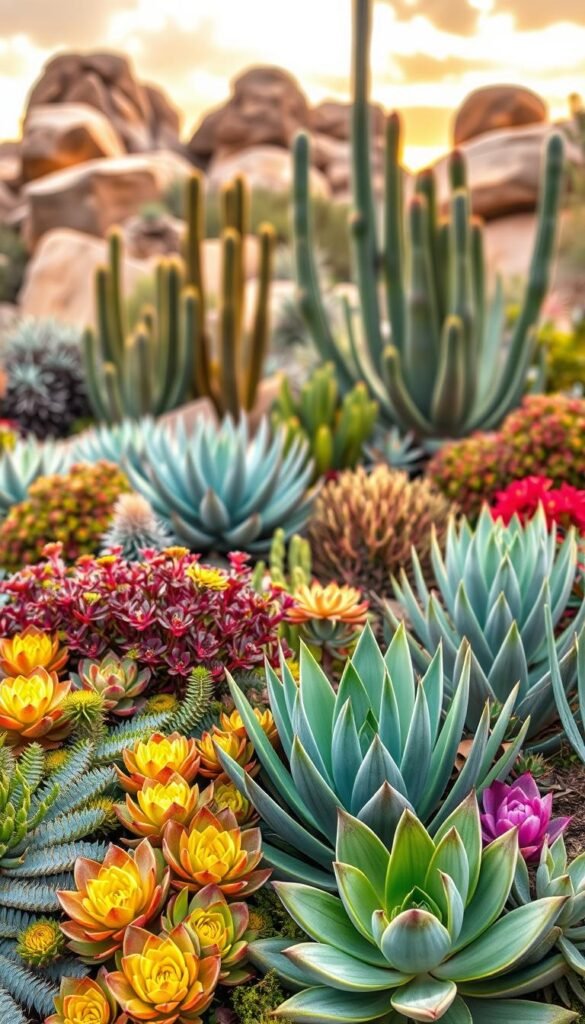Imagine transforming dry, challenging spaces into vibrant living art. What began as basic clusters of jade plants has blossomed into an innovative approach to landscaping that thrives where water is scarce. Pioneers like Debra Lee Baldwin – author of three bestselling books on the subject – have reshaped how we use resilient species to craft eye-catching environments.
Modern arrangements go far beyond mere survival tactics. By mixing textures like spiky agaves with rosette-shaped echeverias, you can create dynamic contrasts that catch the eye. Baldwin’s top picks, including the sunset-hued Crassula and glowing Aeonium haworthii, prove these plants offer more than just drought resistance. They bring unexpected drama to patios, walkways, and larger outdoor areas.
Strategic placement makes all the difference. Grouping odd numbers of barrel cacti creates rhythm, while proper soil preparation ensures roots stay healthy. You’ll discover how balancing sun exposure with pockets of shade helps different varieties flourish. Even small balcony setups can become conversation starters when using vertical arrangements or color-themed clusters.
This guide walks you through professional techniques for building low-upkeep displays that impress in every season. Learn which combinations work best for your climate, how to establish visual focal points, and why repetition matters in cohesive designs. Soon, you’ll approach your outdoor space with fresh eyes – and the confidence to make every planting intentional.
Discovering the Foundation of Your Drought-Tolerant Garden
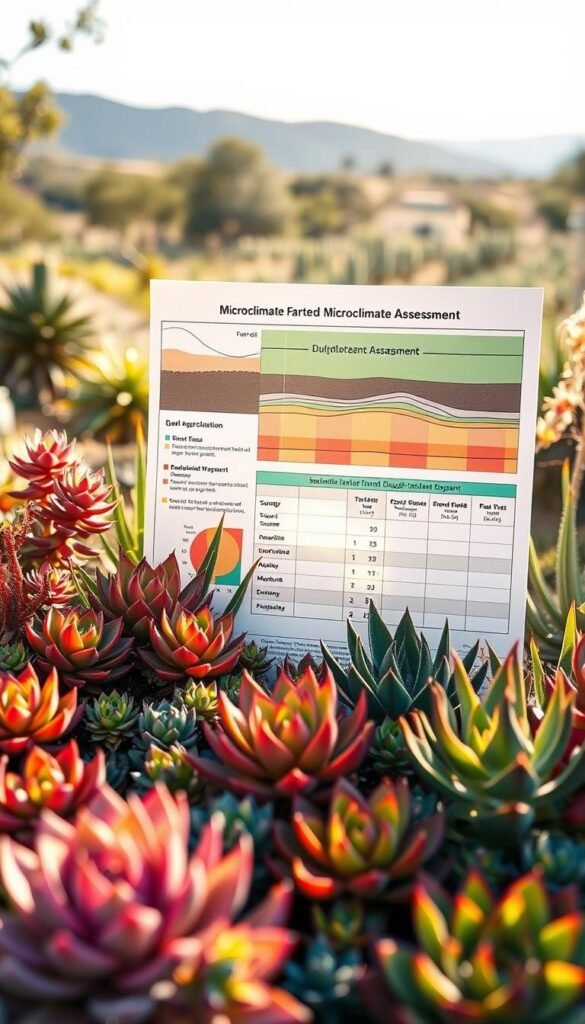
Creating a thriving outdoor space starts with understanding your environment’s unique personality. Like matching plants to a home’s architecture in aesthetic design, your success depends on aligning choices with natural conditions.
Decoding Nature’s Patterns
Track sunlight like a detective. Notice where morning rays hit hardest and which corners stay cool. Wind patterns matter too – breezy spots dry faster, while sheltered areas hold moisture longer.
Soil Secrets & Light Logic
Test drainage with this trick: dig a 12″ hole, fill with water. If it drains in 15 minutes, you’re golden. For slower soils, mix in gritty materials as Baldwin suggests:
“Two parts inorganic grit to one part organic material creates the perfect balance.”
Match light lovers to south-facing zones. Partial shade varieties thrive under trees or along east walls. Remember – leaf thickness often indicates sun tolerance. Thicker leaves usually handle more intense rays.
- Map daily light changes using free apps like Sun Seeker
- Group species by water needs to simplify care
- Use mulch to regulate soil temperature
Essential Elements for a Water-Wise Landscape
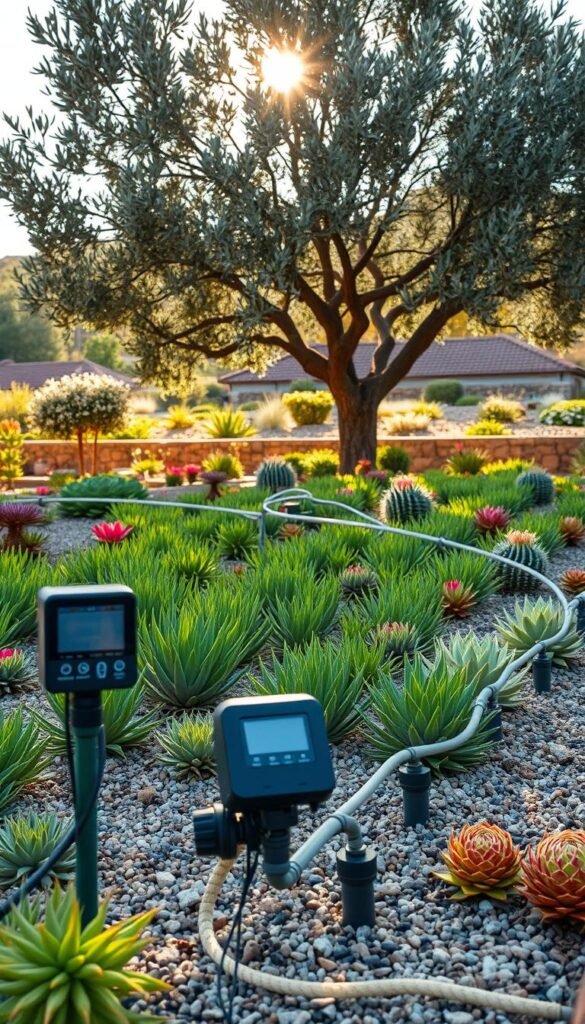
With over 60% of the U.S. experiencing drought conditions last year, rethinking outdoor spaces isn’t just trendy—it’s essential. Building a resilient landscape means pairing smart plant choices with water-saving tech that adapts to your yard’s needs.
Choosing the Right Drought-Tolerant Plants
Move beyond basic options by mixing textures and bloom times. Mediterranean species like lavender thrive in dry summers, while native prairie grasses add movement. Baldwin’s favorites include Agave ‘Blue Glow’ for its sculptural form and sunset jade for fiery accents.
Consider these low-upkeep alternatives to thirsty lawns:
- Feather reed grass (Calamagrostis) for vertical interest
- Russian sage’s purple spires that bloom for months
- Sedum groundcovers that change color with seasons
Incorporating Smart Irrigation Techniques
Modern systems do more than save water—they prevent root rot. Drip lines deliver moisture directly to roots, while weather-based controllers adjust schedules automatically. Baldwin advises:
“Water deeply but infrequently to encourage strong root systems.”
Watch for these signs of trouble:
- Yellowing leaves = often overwatering
- Shriveled stems = needs hydration
- Mushy base = root rot setting in
Pair moisture sensors with gravel mulch to maintain ideal conditions. During heat waves, water early morning to reduce evaporation—your plants will thank you.
Succulent Garden Design: Arranging Drought-Tolerant Plants for Impact
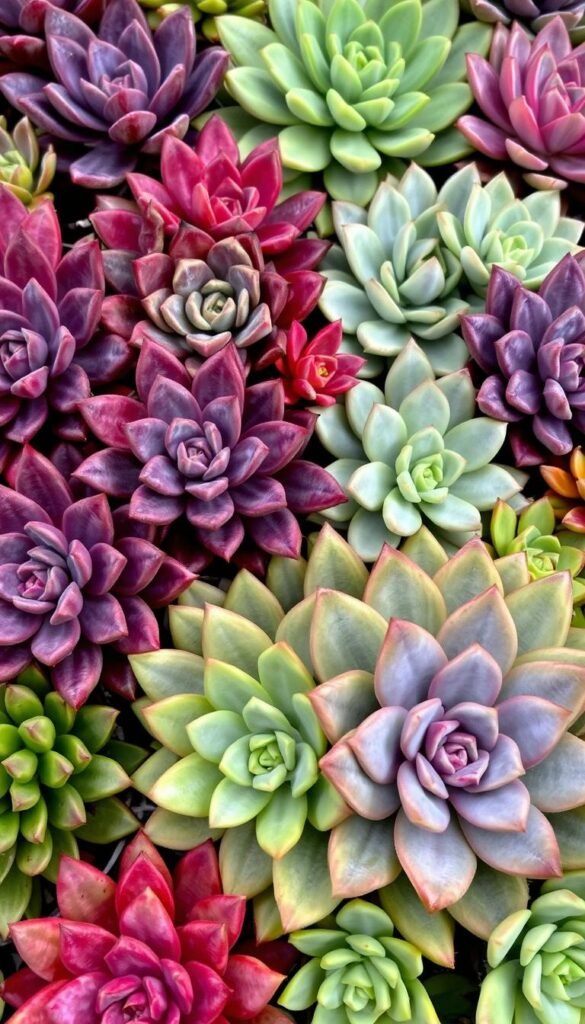
Transform your outdoor area into a living canvas using strategic placement and artistic flair. The secret lies in balancing bold choices with nature’s rhythms—think of it as composing a symphony where every plant plays its part.
Arranging for Color, Texture, and Repetition
Odd numbers create magic. Group three or five barrel cacti to establish rhythm, then repeat clusters throughout your space. Baldwin notes:
“Repeating shapes builds familiarity, while contrasting hues spark excitement.”
Pair purple-toned echeverias with golden sedums for fireworks-like energy. Soften spiky agaves using feathery grasses that sway in the breeze. This mix of textures keeps eyes moving across your design.
Layering and Grouping for Visual Drama
Build height variations like theater staging. Place low-growing hens-and-chicks upfront, mid-height aloes in the middle, and towering yucca as backdrops. For patio container setups, stack pots vertically to mimic this effect.
| Element | Example Pairing | Benefit |
|---|---|---|
| Color Contrast | Blue chalk sticks + Red aeonium | Creates focal points |
| Texture Mixing | Smooth jade + Spiky sotol | Adds tactile interest |
| Repetition | Triangular agave clusters | Establishes visual flow |
Rocks aren’t just decoration—they anchor compositions. Use dark lava stone to make silvery leaves glow, or pale gravel to amplify red-toned varieties. Leave breathing room between plants; overcrowding hides their unique forms.
Mastering Mass Planting and En Masse Techniques
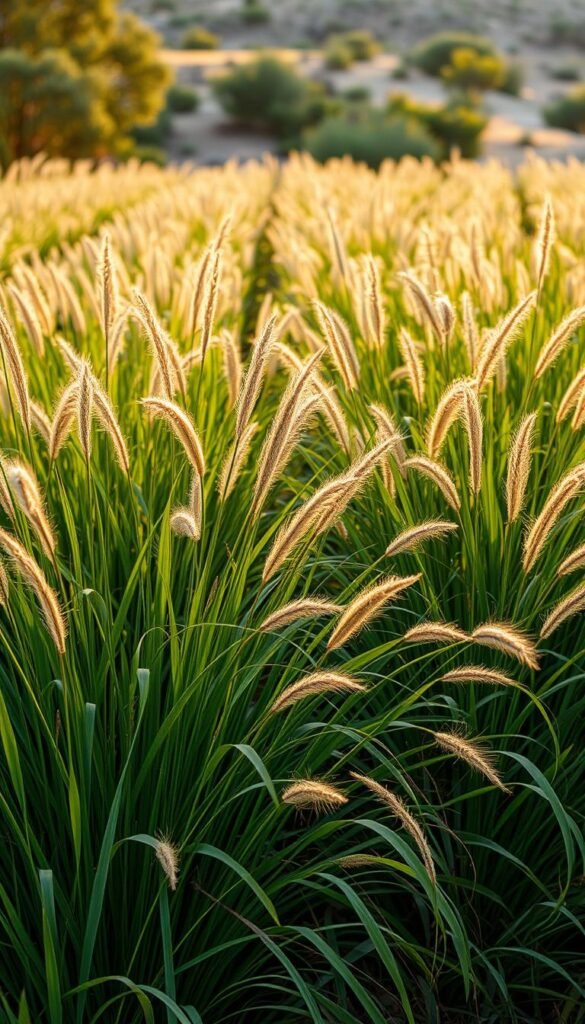
Wave-like drifts of color transform ordinary spaces into living tapestries. This approach uses repetition to create rhythm while conserving resources—a perfect marriage of beauty and practicality.
Creating Impact with Repetition and Color Contrast
Start with seven identical specimens—the magic number for visual punch. Landscape visionaries Oehme and van Sweden proved this works at scale, once planting 3,000 black-eyed Susans where others might use six. Their secret?
“Massing creates movement your eye can’t ignore—like nature’s own brushstrokes.”
Ornamental grasses shine here. Try feather reed grass in sweeping bands. Its vertical lines guide the gaze while allowing airflow between plants.
Balancing Plant Density for Sustainable Growth
Give roots room to breathe. For shrubs, space plants at ¾ their mature width. Groundcovers can snuggle closer—just 6-8″ apart. This table helps plan thriving groupings:
| Plant Type | Recommended Quantity | Spacing |
|---|---|---|
| Summer-blooming perennials | 50+ | 12-18″ |
| Ornamental grasses | 100+ | 24-36″ |
| Woody shrubs | 20+ | 3-4′ |
Use the “elbow test”—if you can’t comfortably reach between plantings, they’re too tight. This ensures healthy growth through dry spells while maintaining that lush, full look you love.
Integrating Environmental Strategies and Expert Pro Tips
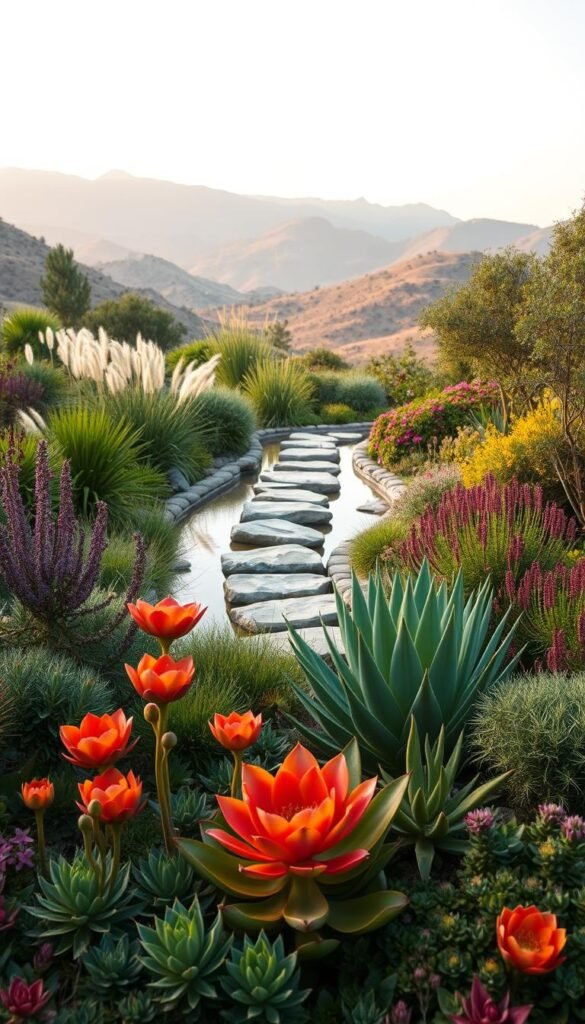
Your outdoor space becomes climate-resilient when you blend smart planning with nature’s rhythms. Let’s explore how to adapt to shifting weather patterns while maintaining stunning visuals.
Adapting Your Design to Regional Climate Challenges
Not all natives thrive in today’s conditions. Some traditional species struggle with extreme heat or erratic rainfall. Baldwin advises:
“Research each plant’s drought threshold—don’t assume ‘native’ equals ‘suitable’ anymore.”
Consider these regional adjustments:
- Southwest: Use decomposed granite for better drainage in heavy rains
- Southeast: Prioritize humidity-tolerant varieties like ghost plants
- Midwest: Mix cold-hardy sedums with ornamental grasses
Spacing becomes critical in dry conditions. For a 6-square-foot bed:
- Limit to eight drought-resistant perennials
- Allow 10-12″ between specimens
- Use gravel mulch to lock in moisture
Insights from Leading Garden and Landscape Experts
Top designers reveal their survival secrets. Integrate sustainable landscape practices with these pro tips:
- Establish new plantings during cooler months
- Use temporary shade cloth during heatwaves
- Group species by water needs for efficient irrigation
Baldwin’s golden rule?
“Choose varieties that maintain structure without constant care—they’ll still impress when you return from vacation.”
Monitor these signs of success:
- New growth within 3 weeks of planting
- Even soil drying between waterings
- Natural color variations through seasons
Wrapping Up Your Creative Garden Journey
Your journey toward a water-smart landscape culminates here – where practicality meets artistry. You’ve mastered the essentials: pairing textural contrasts with strategic repetition, selecting climate-adapted varieties, and spacing for both beauty and plant health. These skills transform barren patches into lively ecosystems that flourish with minimal care.
Expect tangible rewards beyond visual appeal. Debra Lee Baldwin’s resources reveal how these spaces slash water use by up to 60% compared to traditional lawns. Your revamped yard becomes a self-sufficient sanctuary, weathering dry spells and vacation absences with grace.
The benefits multiply over time. Property values often rise 5-15% with low-maintenance landscaping, while reduced mowing and watering shrink your carbon footprint. Regional nurseries now stock exciting options – from silver-toned groundcovers to fiery perennials that shift hues seasonally.
Keep exploring through Baldwin’s tutorials or local workshops. Each planting choice now reflects thoughtful stewardship, blending personal style with environmental care. Your outdoor area isn’t just surviving – it’s telling a vibrant story of resilience.

